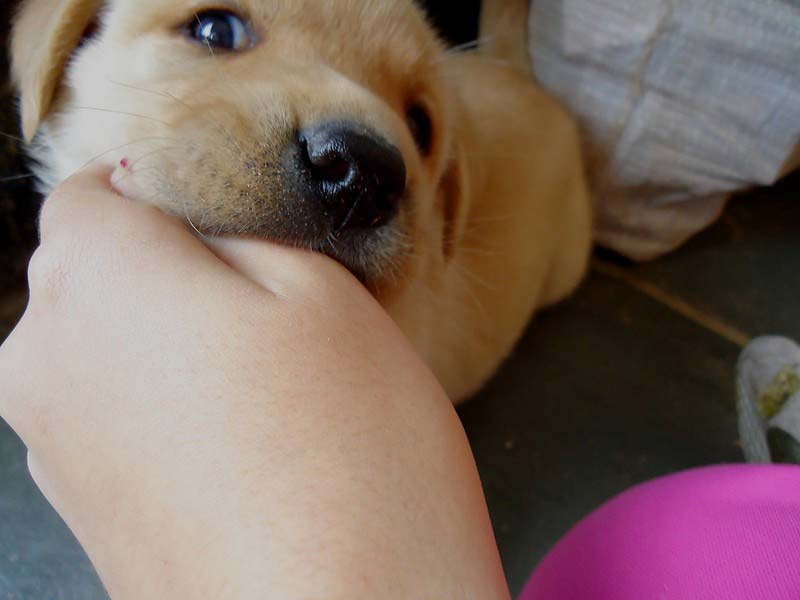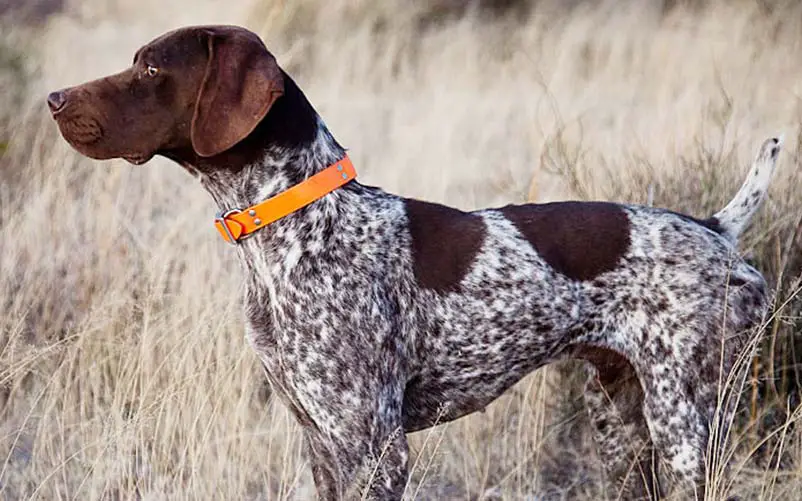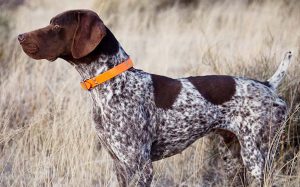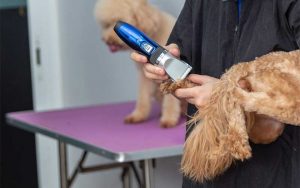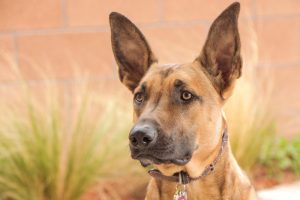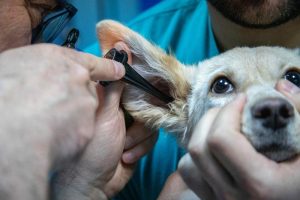
As a common dog breed that you’ll find in most homes in the United States (and all over the world), the Labrador Retriever is typically an extrovert and curious companion that’s easy to train due to their intelligence. However, when it comes to their diet: just how much should you feed a Labrador puppy?
Lab puppies can be prone to a variety of health concerns in their adulthood, such as obesity, joint problems (e.g. hip dysplasia), heart conditions, bloating, and even ear infections. Certain types of food work well with their health conditions while others don’t.
This is why choosing the right kind of food for them is crucial to maintaining a healthy lifestyle and a happy journey to becoming big dogs. Caring for their needs should be your responsibility as their owner, which starts with their puppyhood.
See also:
In the future, your lab puppy will reward you with a sweet and caring friend for life when raised properly! That’s why we wrote this guide to help you figure out how to feed your lab puppy, how much, setting schedules, tips on raw feeding, choosing ingredients and nutrients, and much more.
Page Contents
How much to feed a Labrador puppy?
Lab puppies are best fed on a 3-meal schedule daily, with about 1 cup a day (roughly 9 ounces) divided equally. However, this value still depends on various factors, such as your puppy’s age in months, their weight, the physical activity they have each day, and the like.
Since Labrador retrievers are known for getting joint problems like hip dysplasia in adulthood, they need to have a balanced diet. Too much weight will cause their bones to suffer, leading to joint problems. On the other hand, you also can’t afford to underfeed them, right?
To ensure that your lab puppy gets and maintains the right weight, they should be fed with the recommended amount and schedule. We will list below a guide on how much and how often to feed your Labrador pup depending on their age and developmental milestones.
Feeding Chart
If you are wondering how much and how often your lab puppy needs to be fed, don’t worry – we’ve got you covered! Here is a chart that details the frequency of feeding, as well as the amount of food they should get:
| Puppy age (in months) | Type of food | How much to feed per day | Feeding frequency |
|---|---|---|---|
| Less than 2 | Nursing and weaning, wet and solid food combination | As needed | |
| 2 | Solid food with little water | 1 cup a day | 3 to 4 times a day |
| 3 | Solid food | 1 to 1 ¼ cups | 3 times a day |
| 4 | Solid food | 1 ¼ cups | 3 times a day |
| 5 | Solid food | 1.3 to 1 ¾ cups | 3 times a day |
| 6 | Solid food | 1 ½ to 2 cups | 2 to 3 times a day |
| 7 | Solid food | 1 ½ to 2 cups | 2 times a day |
| 8 | Solid food | 2 to 3 cups a day | 2 times a day |
| 9 | Solid food | 2 to 3 cups a day | 2 times a day |
| 10 | Solid food | 2 to 3 cups a day | 2 times a day |
| 11 | Solid food | 2 to 3 cups a day | 2 times a day |
| 12+ | Solid food | 2 to 3 cups a day | 2 times a day |
We wrote this chart combining the weaning process and the solid food transition so that you’ll know where to begin. Start with as little as one cup per day that’s equally divided into 3 or 4 times throughout the day depending on your puppy’s energy and feeding needs.
As your lab pup grows, they can just be fed 2 times a day but with much more cups of food divided equally. That’s because when they are still young, they can’t digest a lot of food properly so they need to take them in portions first.
Growth Chart
To know if the weight of your lab puppy is just right for their age, we put together a growth chart below. Keep in mind that this is only a general estimate – your vet will give you a more detailed explanation depending on your puppy’s health condition and situation.
| Age in Month | Male Weight | Female Weight |
|---|---|---|
| 1 month | 5.5-6 lbs (2.5-2.7 kg) | 5-6 (2.3-2.7 kg) |
| 2 months | 14-15 lbs (6.3-6.8 kg) | 13-15 (6-26.8 kg) |
| 3 months | 23-26 lbs (10-12 kg) | 22-26 (10.4-12 kg) |
| 4 months | 35-42 lbs (16-19 kg) | 30-38 (16-19 kg) |
| 6 months | 50-60 lbs (23-27 kg) | 44-53 (18-24 kg) |
| 8 months | 58-70 lbs (26-32 kg) | 50-63 (23-28 kg) |
| 10 months | 62-75 lbs (28-34 kg) | 53-66 (24-30 kg) |
| 12 months | 65-77 lbs (29-35 kg) | 55-68 (25-31 kg) |
| 24 months | 65-80 lbs (29-36 kg) | 55-70 (25-32 kg) |
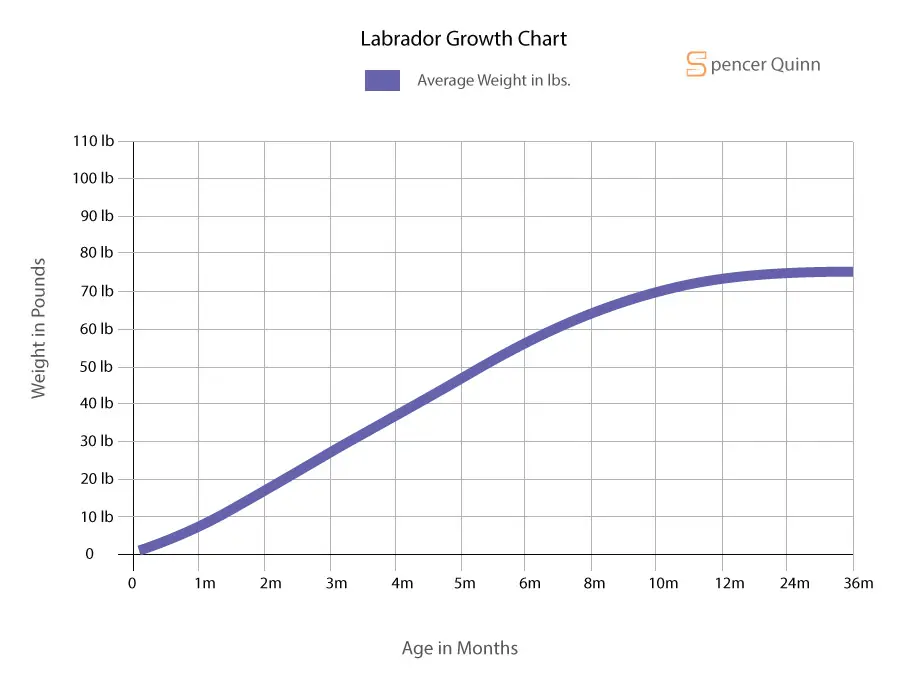
As noted above, males and females differ when it comes to their typical weight ranges, so don’t be alarmed if you think your puppy is heavier or lighter than others – male lab puppies are typically heavier than females. With that said, this is only an estimate as genetics may come into play as well when it comes to your puppy’s weight.
We also have a detailed description of what will likely happen with your puppy’s journey to adulthood, including food changes, behavior, and the like.
2 to 3 weeks old
During their early life stages, Labrador retriever puppies mostly depend on their mother’s milk and thus, cannot be weaned just yet. Keep an eye out for the nursing habits of the mother to ensure that everyone gets a fair share.
Some puppies could be overfed while others are underfed, which may lead to differences in growth later on. If you notice some puppies getting thinner than the other litter members, consider consulting your vet for a puppy formula appropriate for them.
Your puppies will develop most of their motor skills during their 3rd week, leaving them to slowly explore on their own but still watched over by their mother (and you, as their owner). Lab pups might also want to nurse from their mom often due to their energy needs.
Developing milk teeth also happens in the third week for Labrador puppies so it will be a challenge if you start weaning during this time. We think that it’s best to start introducing solid food by around 4 to 5 weeks of age.
4 to 5 weeks old
Getting your lab puppy to eat solid food can begin during this period. Start with a mix of puppy food and water in a ratio of 1:3 – adding liquid will help them digest the solids easier. Look for a brand formulation that’s suitable for lab puppies.
Don’t ever force your lab pup to eat because it will make them nervous. Instead, just wait for them to sniff the food and try to eat it out of curiosity. Try offering the mixture a few times throughout the day in the form of free-feeding so that they’ll get used to the food. Remember to be patient when feeding.
When your puppy reaches 5 weeks of age, they are likely to eat a bit more solid food than they did last week. By this time, you can try to gradually increase the amount of solid food in their bowl.
You may also start to notice the mother doing her job of slowly letting go of her little ones when it comes to the nursing job. In the same way, the lab puppies might also get less interested in their mom’s milk and more curious about the solid food.
This does not generally mean that your puppies will no longer get nursed by their mother – the instances of nursing will only lessen during this transition period. Keep in mind that weaning isn’t something that’s instantly done – it takes a lot of time and effort.
6 weeks old
By 6 weeks of age, your puppy could be enjoying the solid food mixture as compared to their mother’s milk. During this time, you may want to increase the ratio to 3:1 for puppy/solid food and water. This ensures that they’re getting more of the nutrients than the surrounding liquid.
Physical activity is common when your Labrador retriever puppy reaches 6 weeks old. Your pups might also run around even more and become slightly independent compared to when they were younger, which means less time with their mother to get milk.
By 7 weeks of age, your puppies will have far less time being nursed by their mother. This translates to being almost done with the weaning process. Continue feeding them food and liquid mixture until only the solid food is left served in their food bowl.
Aside from that, you may also want to add a bit of age-appropriate kibble (suited for Labrador puppies) that they can chew properly. Excessive canned/wet food might not be good for puppies due to obesity and digestive issues.
Protein is an important part of their diet, which includes meat sources (chicken, beef, and fish), which will help in their energy, strength, and overall health. Consider foods that are rich in protein rather than brands that only contain mostly fillers like corn and wheat.

8 weeks old
Whether you’re a breeder, someone looking for a lab puppy, or raising your puppies from their birth, 8 weeks old is the age when they can be brought to a new home and completely separated from their mother.
The ideal amount of food per day is 2 cups, which should be divided into 3 or 4 meals per day. It’s up to you on how to schedule that – the idea is to keep them full throughout the day without hunger pangs to avoid overfeeding (or underfeeding).
When it comes to weight management, keep in mind that different Labrador breeds do exist. This means that not all puppies should have the same amount of food. Take time to observe your puppy visually if you are feeling their ribs.
If you’re the breeder and someone will adopt the Labrador, you should list down the brand of food and schedules for the new owner to know about. After all, sudden changes in their diet can result in stomach upsets!
Food changes are also important to talk about. If, for some reason, the new Labrador pup owner has no access or little budget for the brand you used, consider close alternatives and make sure they introduce the new food properly, gradually, and slowly.
Later on, during their 9th week, you can also give them home-cooked meals such as meat bought from the wet market. If you’re not sure yet about raw feeding, you should consult your vet if it’s safe depending on your puppy’s health condition.
10 weeks old
During the 10th week, your lab pup should be fed about three cups of food a day. However, you can lessen it if your puppy isn’t too active as compared to other pups, since excess food could cause them to get weight issues.
To avoid food contamination, especially if you live in coastal areas where bacteria could thrive easily, consider removing the food within 15 minutes of not being touched by your pup. This will also help the puppy get disciplined into only eating when they are truly hungry and not out of boredom.
Once your Labrador puppy turns 11 weeks old, you could be surprised at their sudden growth. You may find yourself constantly buying stocks of puppy food since this is their peak developmental stage. Either way, as long as you stick as close to the schedule as possible, everything will be fine.
Stick to feeding your Labrador retriever puppy about three to four meals per day. If your pup is extra active throughout the day, they might need up to 3 cups of food per day, equally divided into the meals we mentioned.
12 weeks old and older
After their growth spurt on the 10th and 11th week, you can cut back on the food amount to two cups per day and portion it into 3 meals. By having three different meals, you are ensuring that your pup gets the right weight and a good amount of nutrition. After all, lab pups tend to eat a lot if not supervised!
Puppies that have histories of bloating from their parents are also best to have a set schedule (even up to 4 meals per day) to ensure that they don’t straight up to gobble their food too fast. If you’re having trouble, you can also use a slow feeder for your Labrador pup.
During their 13th week, lab puppies are likely to roam around and look for items that they might mistake as food. Your job, as their owner, is to keep an eye out for these objects and hide them before little Fido chews them!
On top of that, obesity is a possibility if you haven’t fed your puppy properly, which is why you’ll need to consider a lot of protein in their diet. At times, a Labrador pup might look hungry due to excessive begging, but in reality, it could just be a behavior, so make sure the feeding schedule is strictly followed.
Teething usually begins at 14 weeks of age, which is when you’ll need to provide chew toys to help ease their pain. It will also be a great bonding time with their owner! Moreover, if you’ve trained your lab puppy enough, by this time, they could finally learn how to go by themselves without having to be told.

Recommended Food for Labrador Puppies
On average, your Labrador pup should have around 800 calories if they weigh around 22 pounds. Of course, this number will vary depending on their age, weight, genetics, and daily activities. With that said, what should you feed your lab puppy?
Here are some great ideas on what to feed your pup, which can be found in both store food and raw diet plans.
1. Meaty protein
As with all dogs and most active breeds, a Labrador retriever needs a generous amount of protein in its diet. This includes chicken, beef, and fish, as well as other wild sources. Always look into the ingredients and make sure that a specific meat source is the first ingredient.
Protein helps in developing your puppy’s muscles for adulthood, especially if they are the sporty type. If you are feeding raw meat instead of kibble, make sure it is handled properly to avoid bacterial infection. Another option is to incorporate canned (wet) puppy food with kibble, but make sure it is filler-free.
2. Omega fatty acids
Omega fatty acids are commonly found in fish and other seafood. Fish such as mackerel are good for lab puppies to boost their heart health. After all, heart diseases are common in adult Labrador retrievers so it’s best to prevent them as early as puppyhood.
Aside from that, some omega fatty acids can improve their skin and coat appearance, which will help in handling irritations in the future. Whether you’re feeding your puppy with raw food or store-bought brands, look for omega fatty acids in the list of ingredients.
Labradors are known for being heavy shedders, which is why you’ll need fatty acids to maintain their coat health. We all know the pain of grooming a shedding dog! Couple your lab puppy’s fatty acid meal with proper grooming and the shedding can be reduced to a minimum.
3. Vegetables and fruits
Greens are important for puppies as well because they will help with their overall digestion and their immune system. What’s more, in the wild, fruits and veggies have always been a small part of the canine diet so why not give them a little bit?
4. Organ meat
You may also want to add organ meat to your puppy food, especially if you are feeding raw. Kidneys and liver are common organ meat to look for in a Labrador puppy diet. Whether it’s from chicken or any other meat source, make sure it’s fresh and filler-free.
Organs can be found in store-bought wet or canned food but you can also prepare it at home from the market. Be sure to handle it properly to avoid food contamination.
5. Foods with glucosamine
As mentioned above, joint problems are often experienced by labs when they grow up. To prevent the onset of hip or elbow dysplasia, consider foods that are rich in glucosamine, such as shellfish, chicken feet, and beef bones. Bone soup or broth is also a good source of glucosamine.
Foods to Avoid
While we have some recommended foods for a lab puppy, there are also certain ingredients that you should avoid, such as the following:
Fillers such as corn and wheat
These fillers are often included in most commercial dog foods. While there’s nothing wrong with carbohydrates for dogs, it will cause obesity and give your puppy no nutrient value as compared to meat that contains protein, so it’s best to consider no-filler food.
Labradors are notorious for being prone to weight problems so it’s very easy to feed them too much. If your puppy isn’t very active and eats a lot, consider knowing what goes into their food bowl. Look for foods with fewer fillers and more protein.
An obese puppy may grow into an unhealthy and unhappy dog later on in life. They can catch all sorts of health problems if their weight is not managed properly. For instance, hip dysplasia is more likely to happen if your puppy is too heavy.
Artificial colors and preservatives
If you give your puppy commercial food that’s filled mostly with preservatives and artificial flavorings, it’s not good for their health because it won’t add any nutritional benefit to them. Moreover, sugary foods will cause diabetes if not supervised.
Human foods toxic to dogs
These include chocolate, garlic, avocado, grapes, lime, coffee (caffeine), lemons, tea, onions, sugary foods, macadamia nuts, and most certainly alcohol. Theobromine in chocolate, xylitol in sodas, and grapes are poisonous to dogs, which is why they shouldn’t be fed.
FAQs on Feeding a Labrador Puppy
We want to help you feed your lab puppy better and maintain their overall health. Here are some frequently asked concerns about their meals, diet, and more.
If you notice a big change in their appetite, it can be a cause for concern. Take your lab puppy to the vet if they haven’t eaten all of a sudden – especially after two meals already, and most especially after an entire day of not eating.
Your vet will assess your puppy’s condition and diagnose any underlying cause of their poor appetite and lack of energy. It could be something that they accidentally ate or some other health concern, so it’s better to get your veterinarian to assess the situation.
However, if they only didn’t eat much after one meal, it could be the brand of dog food you served them. Changes in their regular food are a normal reason for a puppy to suddenly stop eating because it is new to them.
Have you tried gradually changing the food in portions? That helps because it won’t shock your puppy’s palate and digestive system. First, put a little bit of the new food and more of the old food, and then gradually increase the portion of the new food after a few meals. That’s how your lab puppy will get used to it.
Generally, lab puppies will already get the nutrients they need from the food you buy or prepare for them. Puppy food is usually manufactured and made to have more nutrients as compared to adult dog food, which is why it should already be sufficient for your Labrador puppy.
Unless your veterinarian advised giving supplements to your puppy due to an underlying health concern, such as joint problems (in which they need glucosamine), you shouldn’t self-medicate your puppy and decide on your own. It’s best to leave this to the animal health experts.
The best time to make the switch is after their first birthday. Usually, by this time, your pup has reached adulthood and is no longer growing in height and weight.
Keep in mind that transitioning from puppy to adult food still requires the ratio method. Put a little bit of the adult food at first into the puppy food mix. Then, gradually increase the ratio of the adult food until it’s the only food left in their bowl.
Raw feeding a Labrador puppy
Many raw diet advocates stress the benefits of feeding this way, such as becoming free from fillers and artificial additives. However, if you’re feeding raw for pups, make sure to get tons of advice!
Get your veterinarian or breeder involved if you want to start feeding a raw diet to your Labrador puppy because when done wrong, it could make your pup sick! Food contamination and miscalculation of calories/nutrients are the common beginner’s mistakes when preparing a raw diet for dogs/puppies.
If you get an expert aboard, you’ll know which foods to buy to complete the entire meal with sufficient nutrients for your puppy. Getting nutritional advice from a vet will help you figure out what’s missing in your puppy’s diet since they know all about pet health and nutrition.
Conclusion
Labrador puppies, when fed properly, carefully, and smartly, will reward you with TLC and a warm companion for the years to come. Be sure to always stick to the schedule or else it could lead to obesity and joint problems later on!
Always make time to prepare the best food for your Labrador pup so that they grow healthy and strong – enjoying life as they go!
